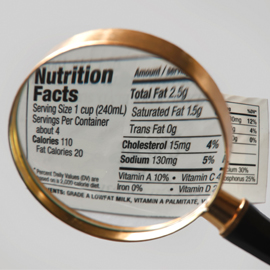Nutrition Labels and LAP-BAND

You’ll be making careful decisions about what you eat after LAP-BAND surgery, and nutrition labels can help. Because they tell you exactly what’s in the food you’re eating, nutrition labels can be your guide to making healthier food choices and sticking to the nutritional requirements of your LAP-BAND.
Nutrition labels are useful after LAP-BAND surgery because they make it easier to:
- Cut calories, carbs and fat from your diet
- Meet your daily protein needs
- Eat more essential vitamins and minerals
Using Food Labels
Here are the different sections of a typical nutrition label and what they mean to you after LAP-BAND surgery:
Serving Size
This section is right at the top, and for good reason—serving size tells you how much you’ll need to eat to get the calories and nutrients below, so it can help you make sense of the rest of the label. Look at how big the serving size is, as well as the number of servings per container. Remember that the whole package isn’t always a single serving.
Calories
Comparing the number of total calories in foods can help you find lower-calorie options. Calories from fat can also quickly give you an idea of a food’s fat content, which can help you find foods that are low in fat.
Nutritional Value
The rest of the nutrition label breaks down the food’s concentration of nutrients like fat, sodium, carbohydrates, protein and fiber. This section will show you how many grams or milligrams of each nutrient are contained in a single serving.
Some nutrients are also listed by percent daily value (abbreviated as % DV). This gives you a general recommendation for how much of each nutrient should be eaten in a 2,000-calorie diet. When the label says a food has 10 percent vitamin A, it means that one serving of the food contains 10 percent of the vitamin A that most people need to eat in a day.
Though percent daily value won’t apply directly to your diet after LAP-BAND surgery, it’s still useful for determining if a food is good or poor source of important nutrients.
- % DV of 20 percent or more means the food is high in that nutrient
- % DV of five percent or less means the food is low in that nutrient.
In general, you should look for foods that are low in fat, sodium and cholesterol. You’ll also need to steer clear of foods that are high in carbohydrates, especially high fructose corn syrup. Of course, chewable vitamins are very important, regardless of normal dietary vitamin intake.
Your protein goal after surgery will be at least 60 grams per day. You can help yourself stay healthy by finding foods that are high in protein and other important nutrients like:
- Vitamin A
- Vitamin C
- Calcium
- Iron
That’s everything you need to know to use a nutrition label after LAP-BAND surgery. By paying more attention to the nutritional value of the foods you eat, it will be easier to meet your nutritional needs and lose weight in a healthy, sustainable way.